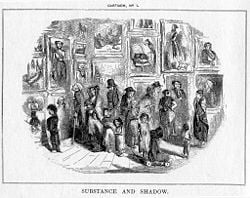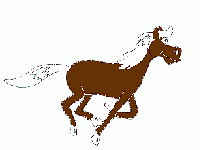Cartoon
The phrase cartoon refers to several forms of art, including humorous captioned illustrations, satirical political drawings, animated films, and full-scale drawings for various forms of fine art, such as frescos and tapestries. From fine art to political commentary and entertainment, cartoons have played an important role in shaping the world as we know it.
Cartoons in Fine Art
In its original meaning, a cartoon (from the Italian cartone, meaning "big paper") is a full-size drawing made on paper as a full size study for artwork. Cartoons were first used for fresco painting, a technique involving the application of pigment to a wet lime plaster wall, during the sixteeth century. Once the composition is drawn on paper, it is then transfered to the plaster wall by one of two techniques. The artist may use a tool to trace over the design, indenting the image into the plaster, or a perforating tool may be used, after which the charcol dust is applied to mark the lines of the composition.
Cartoons by painters such as Raphael and Leonardo da Vinci are proudly displayed in musuems around the world. A world-renowned collection of cartoons for tapestries byPeter Paul Rubens, one of the most famous artists of the seventeeth century, is displayed in the John and Mable Ringling Museum of Art in Sarasota, Florida.
Editorial Cartoons
An editorial cartoon, also known as a political cartoon, is an illustration or comic strip containing a political or social message. Editorial cartoons first made an emergence during the Protestant Reformation in Germany, in the early 1500's. In order to disseminate his ideas to a largely illiterate population, Martin Luther, the leader of the Reformation, turned to the printed image. Images protesting the actions of the powerful Catholic Church were distributed on broadsheet posters and illustrated pamphlets, and proved an effective means of reaching a large portion of the population.[1]
In the United States, the first political cartoon was printed by Ben Franklin in The Pennsylvania Gazette on May 9, 1754. This well known image features a segmented snake with the segments representing colonial governments, and the caption "Join, or Die" below. Based on the popular superstition that a severed snake could be made whole again if the pieces were placed together, the cartoon urged colonial governments to unite during the French and Indian War. The image was reprinted by newspapers throughout the colonies.
It was not until 1843 that the term "cartoon" was used to refer to anything but preliminary sketches for fine art. The phrase was coined by the British magazine 'Punch', a magazine well known for its satirical drawings. At the time, the Houses of Parliament were being rebuilt after a fire, and artists were encouraged to submit preliminary drawings, or cartoons, to help select new paintings and murals. A series of drawings given the title "cartoons" (including John Leech's "Cartoon, No.1: Substance and Shadow") used sarcasm to attack the government's expenditure of money on needless opulence while the poor went hungry. The term "cartoon" stuck as a description of pictoral satire, and eventually expanded to include any form of humorous drawing.[2]
Modern editorial cartoons can be found in most newspapers, and many radical or minority issue editorial cartoonists who might never have been published have established a presence on the internet. Editorial cartoons can be very diverse, but there is a certain established style among most of them. Most editorial cartoons use visual metaphors and caricatures to explain complicated political situations, and thus sum up a current event with a humorous or emotional picture. Some common visual metaphors are the donkey and elephant (symbolizing American political parties), the beaver (symbolizing Canada), the lion (symbolizing Great Britian), and the bear (symbolizing Russia). Although their style, technique or viewpoints may differ, editorial cartoonists all draw attention to important social and political issues.
By their very nature, editorial and political cartoons spark controversy. Cartoons have been used to depict a wide range of political, religious, and social viewpoints, and often touch upon topics that may be sensitive. While such cartoons can often be a positive influence for change, they can also exacerbate exsisting tensions.
Print media
Modern gag cartoons are found in magazines and newspapers and generally consist of a single drawing with a caption immediately beneath or (less often) a speech balloon. Many consider New Yorker cartoonist Peter Arno the father of the modern gag cartoon (as did Arno himself). Gag cartoonists of note include Charles Addams, Gary Larson, Charles Barsotti, Chon Day and Mel Calman.
Comic strips, also known as "strip cartoons" in the United Kingdom, are found daily in newspapers worldwide, and are usually a short series of cartoon illustrations in sequence. In the United States they are not as commonly called "cartoons" themselves, but rather "comics" or "funnies". Nonetheless, the creators of comic strips - as well as comic books and graphic novels - are referred to as "cartoonists". Although humor is the most prevalent subject matter, adventure and drama are also represented in this medium. Noteworthy cartoonists in this sense include Charles Schulz, Bill Watterson, Scott Adams, Mort Walker, Steve Bell.
Motion pictures
Because of the stylistic similarities between comic strips and early animated movies, "cartoon" came to refer to animation, and this is the sense in which "cartoon" is most commonly used today. These are usually shown on television or in cinemas and are created by showing illustrated images in rapid succession to give the impression of movement. (In this meaning, the word cartoon is sometimes shortened to toon, which was popularized by the movie Who Framed Roger Rabbit). Although the term can be applied to any animated presentation, it is most often used in reference to programs for children, featuring anthropomorphized animals, superheroes, the adventures of child protagonists, and other related genres. Animated material which does not fit the traditional conventions of mainstream Western animation, such as Japanese anime are often confused with the definition of cartoons.
In science
The term "cartoon" is sometimes used in a scientific context to mean a diagram, particularly one that depicts a generalised occurrence rather than a specific example.
External links
- CartoonStock database of gag, editorial and historic cartoons
- Punch website's history of cartoons
- New Yorker's Cartoon Bank
- Daryl Cagle's Professional Cartoonists Index
- Don Markenstein's Toonopedia
- Big Cartoon Database
- Golden Age of Cartoons
- A free cartoons directory : The Cartoon Spot
- Toon-Cycle: Cartoon community and media resources
- Russian animated cartoons and World Day of Animated cartoon
- British Cartoon Archive has a database of over 100,000 editorial cartoons published in the British press
- Using editorial cartoons in the classroom Sources, analysis, interpretation (mostly English with some German)
- Goldbrick Gallery: A daily collection of the latest masterstrokes from the sharpest pens in Editorial Cartooning.
Credits
New World Encyclopedia writers and editors rewrote and completed the Wikipedia article in accordance with New World Encyclopedia standards. This article abides by terms of the Creative Commons CC-by-sa 3.0 License (CC-by-sa), which may be used and disseminated with proper attribution. Credit is due under the terms of this license that can reference both the New World Encyclopedia contributors and the selfless volunteer contributors of the Wikimedia Foundation. To cite this article click here for a list of acceptable citing formats.The history of earlier contributions by wikipedians is accessible to researchers here:
The history of this article since it was imported to New World Encyclopedia:
Note: Some restrictions may apply to use of individual images which are separately licensed.
- ↑ Part I: A Brief History of Political Cartoons. The University of Virginia. Retrieved November 28, 2006.
- ↑ History of the Cartoon. Punch Magazine. Retrieved November 28, 2006.


